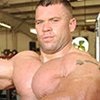Certain trainers with physiques that bring to mind Pee-wee Herman like to pontificate about how developing the "mind-muscle connection" makes about as much sense as joining the Flat Earth Society. As long as you use proper technique when exercising, they pronounce, you'll benefit no matter where your head is at.
But the mind-muscle connection is not some kind of bro science, it is fully supported by real science, and if you think otherwise, you're leaving gains on the table.
Consciously Connect to Your Muscles
The mind-muscle connection refers to the intentional contraction of a target muscle as you exercise. It's the difference between simply moving a weight from point A to point B, versus doing so by consciously activating the specific muscle you are targeting.

The ability to focus your mind on a specific muscle comes down to the process of developing, over time, neuromuscular control and proprioception—the mind-muscle connection. This is easier done when you're doing isolation, versus compound, exercises.
One way to measure the strength of the mind-muscle connection is with the use of electromyography (EMG). EMG measures the electrical activity in a muscle as it tries to overcome resistance: The higher the EMG reading, the more the muscle is engaged in a task.
The "Glute Guy," Bret Contreras, has done research showing that advanced lifters who intentionally focus on a muscle while lifting get a much higher EMG reading than if they just try to move the weight. Other EMG studies have duplicated these findings, demonstrating that if trainees focus on a target muscle they'll activate a higher percentage of the fibers in that muscle. This, in turn, leads to greater hypertrophy.
Train Your Muscles, Not Your Ego
My first and best advice to you is to lose the mentality that all you're doing at the gym is moving around weights. One of the most common reasons why people fail to develop the right mind-muscle connection—and leave gains on the table—is that they focus on how much weight they're moving, not on how much tension they're creating in the target muscle.
To change your habits, begin your lifting session by setting an objective for yourself. If you want to build the most muscle, focus on quality repetitions—activating the specific muscles you're targeting and moving through the proper range of motion. You might also want to read my article about affirmations, in which I talk about the power of positive thought when lifting.

Watch Some Mental Movies
Not just bodybuilding and sports, but all of history, is filled with examples of the role visualization plays in intensifying the mind-body connection.
As the story goes, Muhammad Ali would repeatedly visualize having his hands lifted above his head in victory by the referee. Billy Graham apparently preached thousands of sermons to tree stumps in Florida swamps before he first took the pulpit. And Napoleon is said to have played out different battle scenarios in the theater of his mind before ever stepping into the theater of battle.
Srini Pillay, M.D., an assistant professor of psychiatry at Harvard Medical School, notes in his book "Your Brain and Business: The Neuroscience of Great Leaders," that we use the same part of the brain to visualize an action as we do to perform that action. So, as you do a dumbbell fly, don't just engage any muscle that'll move the weight. Focus your attention on your pecs, visualize your chest filling with blood as you move through the exercise. Feel the contraction during the concentric phase, and the stretch in the eccentric.
You can work on your mind-muscle connection when you're nowhere near a gym. Just repeatedly imagine yourself performing an exercise with perfect form and full attention, and you'll soon be doing it that way. Instead of wasting time scrolling the 'gram, make mental movies of the optimal muscle contractions you'll feel during each rep.
If you don't initiate a dumbbell fly with your pecs or a barbell row with your traps, change your intention! Think first about contracting the target muscle, not about moving the weight. Set your intention, focus on the target muscle, and everything else will follow.
Accentuate the Negative
As you've probably noticed, most people can lower more weight than they can lift. This fact makes many lifters extremely lazy on the negative portion of a lift. To them, the purpose of this portion is just to return the weight to the starting position.
One of the quickest ways to develop a proper mind-muscle connection is to slow down the negative portion and use it to tune in to the targeted muscles. Try this, and if you're still not feeling your target muscle, slow the whole process down with 3-5-second negatives, then watch that muscle begin to grow!
Practice Your Posing
Practicing bodybuilding poses is another way to develop your mind-muscle connection. The late Mel C. Siff, Ph.D., a pioneer of scientific weight training, talked about "loadless" training in his pioneering book, "Supertraining." Loadless training amounts to repeatedly flexing specific muscles without any kind of resistance. In other words, it amounts to posing.

As serious bodybuilders practice their poses, they're also refining their mind-muscle connection. A skilled bodybuilder can move immediately into a lat-spread pose at the drop of a hat. The rest of us? Not so much. And because they practice this specific pose, it's much less likely that their biceps will "take over" when they do lat pull-downs.
Another similar strategy is to isometrically contract the muscle you are targeting for 6 seconds prior to doing the exercise, then immediately perform the exercise. As with posing practice, this technique should help you hone your mind-muscle connection so you can turn it on for every rep.
In sum, Arnold said it best: "Where the mind goes, so goes the body." Use these simple tips to intensify your mind-muscle connection, and soon you'll be making gains of oak-like proportions.
